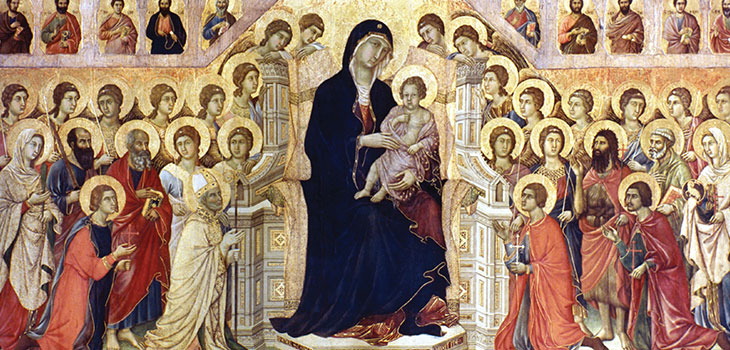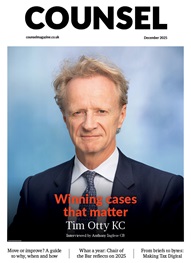*/

Siena in the early 14th century was a city of intense religious and artistic activity. The city was wealthy and successful. There was a strong belief that Siena was favoured and protected by the Virgin Mary. Religious devotion and worship were such that art needed to reach out and almost touch worshippers; to tell an emotional story and to make the experience as real and immediate as possible.
All these elements are present in the sumptuous exhibition of 14th century Sienese art at the National Gallery, which brings together work from museums around the world. The stars of the show are Simone Martini, Duccio di Buoninsegna and the Lorenzetti brothers (Pietro and Ambrogio), with over a hundred exhibits – all gold leaf, lapis lazuli, guilded glass and illuminated manuscripts – pre-dating the Florentine based Renaissance by almost a century.
The exhibition brings together panels from works rarely seen together, most impressively from Duccio’s Maestà (Mary and Jesus at the centre of the work) that once graced the altar of Siena Cathedral (pictured above). Although mesmerising, the altarpiece is also something almost real and tangible, and part of everyday Sienese life and experience. Panels from Martini’s Orsini polyptych come together for the first time in living memory.
The exhibition links the art to Siena’s civic identity with text explaining how the city-state’s political structure, mercantile wealth and spiritual values fostered a unique visual culture. The technical displays explaining gold leaf application and tempera techniques provide valuable context for appreciating these works’ extraordinary craftsmanship. The city at the time was home to a thriving and close-knit group of artists at the cutting-edge of contemporary painting and creation, encouraging and enhancing personal and public worship. Artists’ workshops would have been open to one another and every new technique developed by one painter was immediately known to other artists.
It has been said that the story of trecento Siena and its art is very much about surplus wealth. The relevant accounts for 1333 show that ‘gold’ took up over half the expenditure for the Duomo in that year. Those who controlled that wealth were committed to spending it on the visual representation of the things that mattered to the city. Not only did images of the Virgin everywhere tell visitors of the city’s dedication and its special devotion, but the commissioning of the art represented by this exhibition provided a general assurance to the citizenry and the governing regime of a collective salvation for those who lived in Siena.
This must-see exhibition succeeds spectacularly in revealing how Siena’s artistic golden age fundamentally transformed European visual culture, and reclaims Siena’s place at the heart of art’s evolutionary journey.
Siena – The Rise in Painting 1300-1350 is at the National Gallery until 22 June 2025

Siena in the early 14th century was a city of intense religious and artistic activity. The city was wealthy and successful. There was a strong belief that Siena was favoured and protected by the Virgin Mary. Religious devotion and worship were such that art needed to reach out and almost touch worshippers; to tell an emotional story and to make the experience as real and immediate as possible.
All these elements are present in the sumptuous exhibition of 14th century Sienese art at the National Gallery, which brings together work from museums around the world. The stars of the show are Simone Martini, Duccio di Buoninsegna and the Lorenzetti brothers (Pietro and Ambrogio), with over a hundred exhibits – all gold leaf, lapis lazuli, guilded glass and illuminated manuscripts – pre-dating the Florentine based Renaissance by almost a century.
The exhibition brings together panels from works rarely seen together, most impressively from Duccio’s Maestà (Mary and Jesus at the centre of the work) that once graced the altar of Siena Cathedral (pictured above). Although mesmerising, the altarpiece is also something almost real and tangible, and part of everyday Sienese life and experience. Panels from Martini’s Orsini polyptych come together for the first time in living memory.
The exhibition links the art to Siena’s civic identity with text explaining how the city-state’s political structure, mercantile wealth and spiritual values fostered a unique visual culture. The technical displays explaining gold leaf application and tempera techniques provide valuable context for appreciating these works’ extraordinary craftsmanship. The city at the time was home to a thriving and close-knit group of artists at the cutting-edge of contemporary painting and creation, encouraging and enhancing personal and public worship. Artists’ workshops would have been open to one another and every new technique developed by one painter was immediately known to other artists.
It has been said that the story of trecento Siena and its art is very much about surplus wealth. The relevant accounts for 1333 show that ‘gold’ took up over half the expenditure for the Duomo in that year. Those who controlled that wealth were committed to spending it on the visual representation of the things that mattered to the city. Not only did images of the Virgin everywhere tell visitors of the city’s dedication and its special devotion, but the commissioning of the art represented by this exhibition provided a general assurance to the citizenry and the governing regime of a collective salvation for those who lived in Siena.
This must-see exhibition succeeds spectacularly in revealing how Siena’s artistic golden age fundamentally transformed European visual culture, and reclaims Siena’s place at the heart of art’s evolutionary journey.
Siena – The Rise in Painting 1300-1350 is at the National Gallery until 22 June 2025


Chair of the Bar reflects on 2025
AlphaBiolabs has donated £500 to The Christie Charity through its Giving Back initiative, helping to support cancer care, treatment and research across Greater Manchester, Cheshire and further afield
Q&A with criminal barrister Nick Murphy, who moved to New Park Court Chambers on the North Eastern Circuit in search of a better work-life balance
Revolt Cycling in Holborn, London’s first sustainable fitness studio, invites barristers to join the revolution – turning pedal power into clean energy
Rachel Davenport, Co-founder and Director at AlphaBiolabs, reflects on how the company’s Giving Back ethos continues to make a difference to communities across the UK
By Marie Law, Director of Toxicology at AlphaBiolabs
Are you ready for the new way to do tax returns? David Southern KC explains the biggest change since HMRC launched self-assessment more than 30 years ago... and its impact on the Bar
Professor Dominic Regan and Seán Jones KC present their best buys for this holiday season
Oscar Davies shares their lessons learnt
Little has changed since Burns v Burns . Cohabiting couples deserve better than to be left on the blasted heath with the existing witch’s brew for another four decades, argues Christopher Stirling
Pointillism, radical politics and social conscience. Review by Stephen Cragg KC